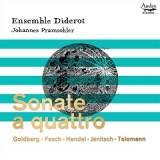Nach der Sonata a tre widmet sich das Ensemble Diderot der Sonata a quattro. « Durch ihr Erscheinen kurz vor dem Aufkommen des Streichquartetts blieb sie weitgehend unberücksichtigt, nahm jedoch eine wichtige vermittelnde Rolle zwischen Barock und Frühklassik ein », heißt es in der Präsentation.
Das Ensemble Diderot findet den richtigen Zugang zu dieser Musik – die sich zwischen dem ausklingenden Barock und dem galanten Stil bewegt, der den Weg für die Empfindsamkeit und den Präklassizismus ebnen sollte – und die hier tatsächlich als eine Kunst im Wandel vorgestellt wird.
Dabei kommt jeweils die Individualität des künstlerischen Ausdrucks zum Tragen, der mitunter das tiefste ‘Ich’ des Komponisten zu ergründen versucht, wie das trefflich in den Moll-Sonaten zu hören ist.
Und so kann man sich an den genauso eloquenten wie handwerklich ausgefeilten Interpretationen des Ensembles Diderot nur erfreuen.
After the Sonata a tre, the Ensemble Diderot now turns its attention to the Sonata a quattro. « Due to its appearance shortly before the emergence of the string quartet, it remained largely unconsidered, but took on an important mediating role between the Baroque and early Classical periods, » the presentation states.
The Ensemble Diderot finds the right approach to this music which is presented here as an art in transition. Indeed, it moves between the fading baroque and the galant style that was to pave the way for Empfindsamkeit and pre-classicism.
In each case, the individuality of the artistic expression comes to the fore, which sometimes tries to fathom the deepest ‘I’ of the composer, as can be heard splendidly in the sonatas with minor keys.
And so one can only enjoy the eloquent as well as technically sophisticated interpretations of the Ensemble Diderot.
























